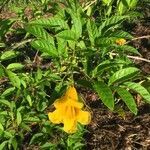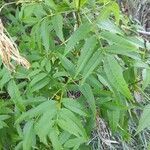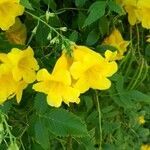Shrub or small tree to 10 m tall and 25 cm d.b.h., the bark dark and ridged; twigs lepidote and irregularly subpuberulent, more or less terete, drying dark brown when young, light brown when mature. Leaves (in Panama) impari-pinnately compound, 3-9-foliolate, the first pair of leaves on a new branch This content downloaded from 192.104.39.2 on Tue, 14 May 2013 16:10:35 PMAll use subject to JSTOR Terms and Conditions960 ANNALS OF THE MISSOURI BOTANICAL GARDEN [VOL. 60 often simple or 1-foliolate, the leaflets opposite, serrate, lanceolate, apically acute, basally cuneate, the terminal leaflet often attenuate, 2.4-15 cm long and 0.8-6 cm wide, progressively larger distally, somewhat lepidote above and beneath, simple puberulous on the midvein above and beneath, often puberulous beneath at the base of the secondary nerves and sometimes on the leaf surface, espe-cially in the vein axils; petiolules of the lateral leaflets lacking or to 2 mm long, the terminal leaflet 4-20 mm long; petiole 1-9 cm long, rachis lacking (in 3-foliolate leaves), to 8 cm long, petiole and rachis slightly lepidote, puberulous at the leaflet bases. Inflorescence a terminal or subterminal raceme of to 20 flowers, only a few flowers opening at a time; pedicels and inflorescence rachis lepidote. Flowers fragrant with a sweet odor similar to vanilla; calyx elongate-cupular, evenly 5-dentate, the teeth ca. 1 mm long and usually apiculate, 3-7 mm long and 3-4 mm wide, somewhat lepidote throughout, ciliate with con-spicuous sunken submarginal glands; corolla yellow with 7 reddish lines in the throat, 2 additional fainter red lines on top of throat ridges and a short faint line at the base of the 2 upper lobes, tubular-campanulate above a narrowed base 0.9-1.0 cm long, 3.5-5.8 cm long and 1.2-2.4 cm wide at the mouth, the tube 3.0-4.3 cm long, the lobes 1.0-1.6 cm long, glabrous outside with a glandu-lar epidermis, inside glabrous except for gland-tipped trichomes at the level of stamen insertion and twisted trichomes in sinuses and on throat ridges; stamens didynamous, the anther thecae divaricate, 3.5 mm long, pubescent with twisted, simple, multicellular trichomes, the longer filaments 2.1-2.4 cm long, shorter filaments 1.5-1.8 cm long, the staminode 4-5 mm long, inserted 8-9 mm from the base of the tube; pistil 3.1-3.4 cm long, ovary narrowly cylindric, 3 mm long and 1 mm wide, glandular-lepidote, the ovules 2-seriate in each locule; disc cupular-pulvinate, 1 mm long and 1 mm wide. Capsule linear, tapering at the ends, subterete when fresh, 7-21 cm long and 5-7 mm wide, surface lenticellate, more or less glabrous, sometimes slightly and incon-spicuously lepidote; seeds 3-5 mm long and 2.4-2.7 cm wide, wings hyaline-membranaceous, sharply demarcated from the seed body.
More
Shrub or sometimes small tree to 5 (–8+) m high. Leaves pinnate, 8–25 cm long; leaflets usually 3–7 but sometimes up to 13, ovate-lanceolate, 2.5–10 cm long, 8–30 (–35) mm wide, cuneate base, serrated-toothed margin, acuminate apex, ± glabrous (softly hairy below in var. velutina); petiole 1–6 (–8) cm long; lateral petiolules 1–2 mm long. Inflorescences 5–15 cm long. Calyx cupular to campanulate, 5–7 mm long, the 5 lobes c. 1 mm long. Corolla tubular to funnel-shaped, 3.5–5 cm long, bright yellow with reddish lines in throat which also has slight ridges with long hairs, the 5 rounded lobes 0.8–3 cm long; some cultivars, including hybrids, have orangy to reddish flowers. Stamens included. Capsules pendulous, linear-oblong, somewhat flattened, 7–22 (–30) cm long, (5–) 9–20 mm wide; winged seeds flat, c. 20 mm long and 6 mm wide (including wing surrounding oblong-oval shaped seed), the wing at each end of the seed white-transparent, papery.
Shrub, up to c. 1-4 m. Leaflets 1-3 pairs (cult, sometimes 1-foliolate) lanceolate, acuminate, serrate, glabrous, but often along midrib laxly hairy, 3-10 by 1-4 cm, cuneate at the base, no proper petiolules; petiole 2-5 cm. Racemes glabrous, c. 5-15 cm. Pedicels 5-10 mm. Calyx campanulate, 5-7 mm, usually with some impressed plate-shaped glands in middle part or upper half, lobes short-ciliate. Corolla yellow, 3½-5 cm, limb up to 3½ cm Ø. Stamens included, anther-cells ± pilose. Capsule acute, often lenti-cellate, 10-22 by ½-¾ cm. Seeds (incl. wings) 2 by ½ cm, inserted in two rows on the margins of the septum.
Shrub or small tree, 2-4(6) m high; evergreen. Leaves pinnate, leaflets 5-13, lanceolate, bright green above, paler below; margins toothed. Flowers in terminal sprays, bright yellow, reddish striated. Corolla tubular-campanulate above narrow base, five-lobed. Flowering time Oct.-May. Pollination by bees. Fruit a brown, linear capsule. Seeds papery winged.
A tree. It grows 7 m all. It does not have spines. The bark flakes into vertical strips. It is pale brown. The leaves ahve sharp teeth. They are compound. The flowers are in large branched clusters. The flower tube is yellow with red lines in the throat. The fruit are 7-32 cm long.
Yellow Bells is a small, erect, ornamental shrub with showy yellow flowers.
Disturbed sites, near settlement and gardens, recorded from roadsides, parkland, agricultural land, wasteland, open eucalypt forest, woodland, bushland gullies, grassland, rainforest, river banks/riparian areas, wetland, beach habitats/sand dunes.
More
It is a tropical plant. It grows in coastal areas and along roadsides in full sunlight. It can tolerate drought. In Argentina it grows from sea level to 1,700 m above sea level.
Prefers dry and disturbed areas such as roadsides but it can also be found in relatively undisturbed forests.











